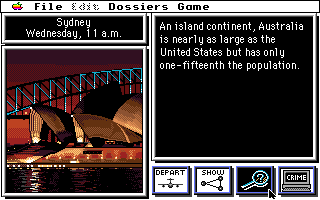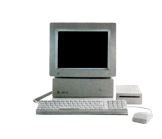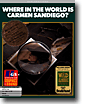Where in the World is Carmen Sandiego?
Your Rating: Not Yet Rated
Average Rating: 4.7 (9 people have rated this item.)
RAM Requirement: 512k RAM
Control: Mouse or Keyboard
Release Status: Abandonware
Year: 1989
For Ages: 10 and up
Publisher: Broderbund
Developers: Loring Vogel
System 6 Compatible: Yes
Hard Drive Installable: Yes
 Download 2image Archive (2020k)
Download 2image Archive (2020k)
 Download the manual in PDF format (5547k)
Download the manual in PDF format (5547k)
All ebay results related to this archive:
Macintosh CD Game Lot, SimAnt, SimFarm, Where in the World is Carmen SanDiego
Vintage 1985 Broderbund *WHERE IN THE WORLD IS CARMEN SANDIEGO?* Apple II Disk
Where in the World is Carmen Sandiego? Broderbund Apple
Current Apple IIGS related Auctions Listed By Time Left:
Vintage Software Apple II IIe IIc IIgs RUSSIA The Great War in the East
LEGO TC Logo - Super Rare DACTA - APPLE IIe & IIgs - Interface Card & Cable 9767
Apple ADB Touchpad Mouse Mice Replacement for G5431 m1042 M2706 A9M0331 IIGS IIe
Phonics Prime Time 1.0 by MECC for Apple II+, Apple IIe, Apple IIc, Apple IIGS
Sound Tracks 1.0 by MECC for Apple II+, Apple IIe, Apple IIc, Apple IIGS

Where in the World is Carmen Sandiego was first released for the 8-bit Apple II in 1985. It was subsequently ported to the IBM PC, Commodore 64, the Macintosh and just about every other platform out there. It spawned many sequels - Where in the USA, Europe, Time and America's History is Carmen Sandiego. The Carmen Sandiego franchise, created by Gene Portwood and Lauren Elliot, is still alive today at Broderbund, but it's a very different company these days.
Carmen Sandiego really is one of the best examples of how computers (not particularly 'powerful' computers by today's standards) can be so engaging, entertaining and educational. The game is designed to encourage research and exploration skills to kids by giving the game the tangible assignment of catching a criminal in a race against the clock. To catch the thief, who is randomly chosen from ten kleptomaniacs for each assignment, you need to use brains, not brawn, to bring the culprit to justice and return the stolen property.
The game begins with you signing in to the ACME Detective Agency and being informed of the latest heist and your latest assignment. The thief can strike anywhere in the world, stealing anything (some are downright funny, including the Statue of Liberty's torch!). You then have to collect clues at the scene of the crime, which will divulge where your suspect will go next in the hope of catching up with them for an arrest. These clues can range from which currency the suspect was converting to the colours used on the flags of their cars.
This is where the World Almanac, which is included with the game, comes into play and where players do their research work to find the answers to the clues given. It was probably no accident either that it was also designed as a form of copy protection, as the game is too difficult to play for beginners without the Almanac.
The real beauty of the game's design is that it can be replayed again and again and never be the same. Even if you make the Detective Hall of Fame, you can still be continually challenged if you start a new detective profile, because different assignments will always present new challenges.
The IIGS version is well made, but unfortunate in that it requires two disks (necessitating a disk swap or two 3.5 inch disk drives) and seems to require every system tool to run the game. The pull down menus work well to access all features of the game. The graphics are very well executed, utilising colour palette changes between countries. The sound and music are also well done. The game can be installed on a hard drive and runs no problem with System 6.



